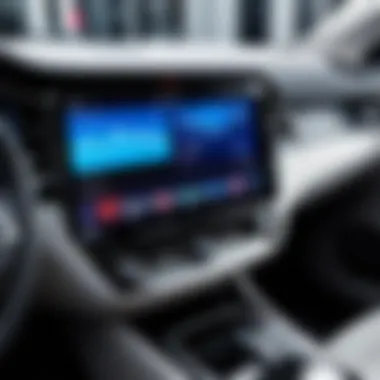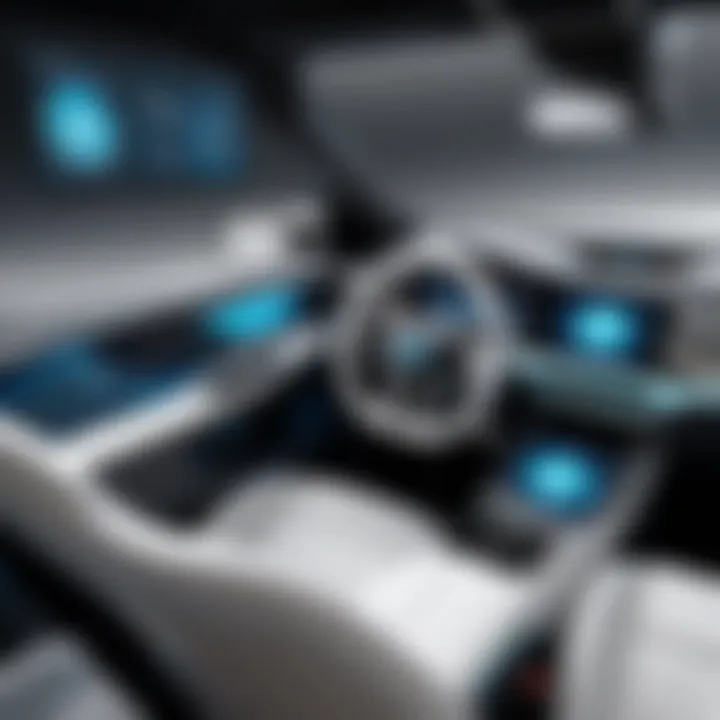Exploring the Complexity of Vehicle Software Technology


Intro
In the age of rapid technological advancements, vehicle software stands as a cornerstone of modern automotive innovation. Gone are the days when automobiles were merely mechanical collections of parts. Today's vehicles are increasingly becoming sophisticated machines equipped with intricate software systems that control everything from engine performance to driver infotainment and even navigation. This article seeks to explore the complexities of vehicle software, providing an analytical perspective that dives deep into its evolution, functionality, and the implications for the future of mobility.
Overview of Software
When discussing vehicle software, it’s essential to lay down the groundwork by understanding its purpose and use cases. Embedded systems, for example, serve as the brain behind many key vehicle functions. They monitor and control the engine parameters, managing everything from fuel injection to emission controls, ensuring optimal performance and efficiency.
Purpose and Use Cases
The primary purpose of vehicle software can be outlined in several crucial areas:
- Engine Control: Software plays a vital role in interpreting data from sensors and executing commands to optimize engine performance. This is often referred to as the Engine Control Unit (ECU).
- Infotainment Systems: These interfaces keep drivers connected while on the road. They allow for access to navigation, music, calls, and even social media.
- Driver Assistance: From parking aids to collision avoidance systems, software underpins features that enhance safety and make driving more convenient.
- Autonomous Driving: Advanced software algorithms are fundamental in enabling vehicles to navigate roadways without human input, marking a significant milestone in automotive technology.
Each of these use cases contributes to an increasingly connected and intelligent driving experience, transforming how we perceive mobility.
Key Features
The software used in vehicles isn't just a one-size-fits-all solution. It showcases a variety of features tailored to meet diverse needs:
- Modularity: This allows for easy updates and the integration of new functionalities as technology evolves.
- Interconnectivity: Vehicle software must communicate with a multitude of external systems, whether they be other cars, infrastructure, or cloud platforms.
- Real-Time Capability: Many functions require instant data processing and response, especially when dealing with safety features.
- User-Centric Design: The interfaces are structured to be intuitive, minimizing driver distraction and enhancing the overall user experience.
“The evolution of vehicle software is not just about functionality but about creating an engaging experience for the user, tailored to their needs.”
In-Depth Review
Having established a framework, we can now delve deeper into the intricacies that underscore the functionality and user experience derived from vehicle software.
Performance Analysis
Performance in vehicle software can be examined through various lenses, including speed, accuracy, and reliability. Take, for instance, the software responsible for adaptive cruise control. It must make rapid calculations to adjust speed, maintaining a safe distance from the vehicle ahead. Any lag can lead to catastrophic consequences.
Furthermore, continuous updates from manufacturers enable software to learn from real-world scenarios. Data collected from vehicles allows companies to refine their algorithms, enhancing performance not just for one vehicle but across all that utilize the same system. This continuous feedback loop underscores the importance of dynamic software in ensuring optimal vehicle operation.
User Interface and Experience
The user interface (UI) is equally as pivotal in vehicle software as the systems that power it. A well-designed UI can make the difference between a mundane drive and a seamless experience. The focus is on ensuring that drivers can access critical information without taking their eyes off the road for too long.
- Touchscreens: Many modern vehicles incorporate large touch displays, making navigation between functions relatively straightforward.
- Voice Commands: Hands-free interaction has emerged as an essential feature, allowing drivers to issue commands while keeping their hands on the wheel.
- Personalization: Many infotainment systems now allow users to customize their interfaces, making frequent tasks more accessible.
Understanding how these elements come together can significantly impact overall consumer satisfaction and safety.
Understanding Vehicle Software
In the age where technology permeates all facets of life, understanding vehicle software becomes paramount. The automotive industry is no longer confined to mere mechanics; it’s now an intricate dance of code and hardware. A modern car operates much like a mobile computing device, making it essential to grasp the complexities of its software.
Vehicle software plays a critical role not only in the operational capacity of vehicles but also in safety, performance, and user experience. There is a vast array of software running in a typical vehicle, from systems that control engine functions to those that manage entertainment features, which leaves many professionals pondering how these components interact seamlessly.
Benefits and Considerations
To understand vehicle software, one must recognize its benefits and the considerations that come with it.
- Enhancement of Safety: Safety features, such as automatic braking and stability control, rely heavily on precise software algorithms. Understanding these systems can help developers improve this critical aspect.
- Performance Optimization: Software algorithms are key in optimizing fuel efficiency and reducing emissions. A thorough understanding enables developers to innovate better solutions.
- User Interface and Experience: Infotainment systems integrate navigation, music, and communication tools, creating a significant part of user experience in vehicles. A clear grasp can lead to enhanced designs and functionalities.
However, delving into vehicle software isn’t without its challenges. Developers must navigate a labyrinth of regulations, compatibility issues, and security concerns that require rigorous understanding and continual vigilance. Fast-paced developments in AI, machine learning, and connectivity dictate that software must adapt swiftly to meet new standards and user expectations.
"Understanding vehicle software is not just an academic exercise; it is crucial for anyone looking to make an impact in the automotive technology sector."
With this in mind, exploring the definition and scope of vehicle software can further enrich our comprehension of this pivotal field.
Definition and Scope of Vehicle Software
Vehicle software encompasses a diverse range of programs designed to control various functions within a vehicle. This includes not only operational systems, like anti-lock braking and engine control units (ECUs), but also performance monitoring systems and user interfaces for navigation.
Additionally, the scope of vehicle software extends beyond the vehicle itself, linking the car to mobile applications and cloud-based services for enhanced functionality. This interconnectedness reflects the modern consumer's expectations for continuous connectivity and real-time updates.


Historical Context: Evolution Over Time
The journey of vehicle software is fascinating and mirrors the evolution of technology itself.
In the early days of the automotive industry, software was rudimentary at best, merely facilitating basic functions. The rise of embedded systems in the 1980s marked a significant shift, introducing sophistication that began shaping vehicle dynamics. Over the years, the advent of microcontrollers in vehicles paved the way for the integration of advanced features.
By the late 1990s and early 2000s, we saw the onset of infotainment systems, revolutionizing how drivers interacted with their vehicles. As vehicles evolved into platforms for extensive software applications, the focus extended to user-centered design, improving not just functionality but also overall driving satisfaction.
Fast forward to today, and it's clear that vehicle software isn't just a support system; it invokes changes in how we perceive mobility, opening doors to autonomous driving, more efficient energy use, and always-on connectivity.
Types of Vehicle Software
Understanding the different types of vehicle software is crucial to grasping the broader implications it has on today’s automobiles. This segment dives into the distinct categories of software that enhance the functionality and experience of modern vehicles. Each category plays a unique role, contributing to safety, connectivity, and overall performance, making it essential for both consumers and developers in the automotive tech landscape to appreciate the nuances involved.
Embedded Software Systems
Embedded software systems are often the unsung heroes in vehicle technology. These software solutions are tightly integrated with the hardware of the vehicle and manage critical functions such as engine control and braking systems. This software is not just an accessory; it's a lifeline that ensures the car operates safely and efficiently.
Consider, for instance, the complexity involved in the engine control unit (ECU). The ECU relies on precise algorithms to monitor various inputs like engine temperature, throttle position, and oxygen levels. By continuously processing this data, it can swiftly adjust fuel injection and ignition timing to optimize performance.
The impact of these systems is profound. A well-tuned ECU results in improved fuel efficiency and reduced emissions, contributing positively to environmental goals. Yet, these systems are also vulnerable. A flaw in the embedded software can lead to catastrophic failures—think of the implications if a software glitch causes braking systems to malfunction.
Infotainment Systems
Moving into the realm of infotainment systems, we find software designed to enhance the driver and passenger experience. Infotainment combines entertainment, information, and personalization in vehicles. These systems integrate features like navigation, media playback, and smartphone connectivity.
For example, take the popular Apple CarPlay and Android Auto platforms. They serve as a bridge between smartphones and vehicle systems, allowing users to access apps, make calls, and dictate messages hands-free. This seamless integration not only elevates user experience but also helps keep drivers focused on the road.
However, the challenges are not to be overlooked. The diversity of devices and operating systems adds layers of complexity. Developers must ensure compatibility across a range of platforms and updates to provide a smooth, bug-free experience, as users generally expect nothing less in this digital age.
Telematics Software
Telematics software provides a comprehensive view of vehicle diagnostics and location services, marrying data with communication technology. This type of software is essential for fleet management, navigation, and connected car experiences, making it an invaluable tool for car manufacturers and fleet operators.
For instance, telematics helps monitor vehicle health in real-time, offering insights into maintenance needs before they become serious issues. Imagine a scenario where a fleet manager receives alerts about tire pressure drops across several vehicles. Swift action can prevent a potential accident and save significant repair costs down the line.
Additionally, features like vehicle tracking enable efficient route planning, enhancing logistic services. As more cars become connected, the importance of robust telematics software will keep growing, requiring advanced strategies to handle the data influx and maintain security.
Autonomous Driving Software
The crown jewel of vehicle software is arguably the autonomous driving software. This technology is at the forefront of innovation, aimed at reducing human input in driving tasks. It involves advanced algorithms, machine learning, and vast computational resources to navigate vehicles in a dynamic environment.
Take Waymo, for example, which utilizes a suite of sensors coupled with real-time data to interpret surroundings and make driving decisions. The intricacy of detecting pedestrians, lane markings, and signals cannot be overstated. Autonomous systems must constantly adapt, responding to unpredictable elements on the road.
While the technology is remarkable, it’s fraught with ethical and regulatory challenges. Concerns about liability in the event of an accident and the potential for cyber-attacks on these systems underline the ongoing debates in this field.
In summary, the various types of vehicle software represent the backbone of modern automotive technology. From embedded systems that keep the engine running smoothly to autonomous driving software that holds the promise of a futuristic road, each category demonstrates the interplay between innovation and everyday functionality in the automotive sector.
The Role of Vehicle Software in Modern Cars
The automotive industry has undergone a profound transformation over the last few decades, largely fueled by the advancement of vehicle software. This digital backbone not only controls key functionalities but also enhances safety, boosts performance, and elevates the overall user experience. The complexity of vehicle software is a defining feature of modern cars, making it essential to understand its multifaceted role in today’s driving landscape.
Enhancing Safety Features
When talking about vehicle safety, software plays a critical part that often goes unnoticed by the average driver. Today’s cars come equipped with an array of safety technologies that rely heavily on intricate software systems. Take the anti-lock braking system (ABS) as an example; it does more than just prevent wheel lock during hard braking. Through real-time monitoring, ABS software communicates with various sensors to apply brakes intelligently. By making split-second decisions, this software can mitigate accidents, effectively broadening the safe driving envelope.
- Advanced Driver Assistance Systems (ADAS) take this a step further. Features like lane-keeping assist and adaptive cruise control depend on robust software algorithms to interpret data from vehicle sensors. This software analyzes road conditions and surroundings, adjusting vehicle behavior accordingly to provide an extra layer of safety.
Furthermore, software updates are vital for maintaining these safety features. Manufacturers frequently release updates to tweak algorithms based on real-world data, which ensures that the safety measures keep pace with evolving driving environments and challenges. Thus, it's clear that software doesn't just uphold safety standards; it is an ever-evolving guardian on the road.
Improving Performance and Efficiency
In addition to safety, the role of vehicle software extends into enhancing performance and operational efficiency. Engine control units (ECUs) utilize sophisticated software to optimize fuel usage and emissions. For instance, the software can modify fueling and ignition timing based on real-time data like throttle position and engine temperature. This fine-tuning allows for smooth engine performance and boosts fuel efficiency, a significant consideration in today's eco-conscious market.
- Moreover, hybrid and electric vehicles showcase how software can redefine performance. Battery management systems, crucial in these vehicles, rely on advanced algorithms to balance energy consumption and optimize battery health. The software can make recommendations regarding charging habits based on driving patterns, further enhancing efficiency.
- In a similar vein, performance tuning software can dramatically alter the dynamics of high-performance vehicles. By allowing users to adjust parameters like power output or handling characteristics via a user-friendly interface, manufacturers empower drivers to personalize their experience, making mundane commutes feel like exhilarating journeys.
User Experience and Connectivity


Today's drivers are not just looking for a means to get from A to B; they seek an experience that is increasingly interconnected. The integration of infotainment systems ranks high among consumer preferences, and here, software plays a starring role. These systems allow apps, navigation, and even social media to merge seamlessly with the driving experience.
- Connectivity through smartphone integration—be it Android Auto or Apple CarPlay—ensures that drivers can access crucial information without taking their eyes off the road. Software allows for hands-free operation of music and calls, thereby reducing distractions.
- Furthermore, the rise of Over-the-Air (OTA) updates has revolutionized how drivers interact with their cars. Instead of waiting for scheduled service intervals to enjoy the latest features, drivers can have software updates delivered right to their vehicle. This means enhanced functionality, user interface improvements, and even new entertainment options, all without a trip to the dealership.
Integration Challenges of Vehicle Software
The realm of vehicle software is not just marked by innovation but also by the considerable challenges that come with integrating various software systems within modern vehicles. As automotive technology advances, the complexity of incorporating software solutions grows, making it critical to understand these integration challenges.
Effective integration is essential for the seamless functioning of vehicle systems, affecting everything from safety to user experience. By examining the roadblocks that appear during this integration, one can grasp not only the barriers faced by developers but also the implications for the automotive industry as a whole.
Compatibility with Hardware Components
One major hurdle in vehicle software integration is ensuring compatibility with various hardware components. In vehicles, numerous sensors, devices, and modules collectively contribute to performance and safety.
- Diverse Hardware Architecture: Modern vehicles incorporate a range of hardware architectures—some using traditional circuitry, while others employ advanced technologies like Field Programmable Gate Arrays (FPGAs) and microcontrollers. Each architecture poses unique challenges when integrating software, requiring developers to tailor their solutions accordingly.
- Communication Protocols: Different hardware components often operate on distinct communication protocols, such as CAN (Controller Area Network) or LIN (Local Interconnect Network). This divergence necessitates software that can efficiently translate commands and data between components, potentially leading to issues like data loss or miscommunication.
- Performance Optimization: Hardware components come with their performance limits, making it vital for software to operate within these constraints. For instance, integrating real-time processing software with existing hardware may require extensive optimization to prevent lag or failures during critical operations such as braking.
Understanding these compatibility challenges is not just for smooth functionality; it's crucial for enhancing overall vehicle safety and user experience.
Scalability of Software Solutions
Another significant integration challenge is the scalability of vehicle software solutions. As vehicle technology grows, software systems must be adaptable to incorporate new features or updates without necessitating a complete overhaul.
- Future-Proofing: The automotive industry is rapidly evolving, with new technologies emerging almost daily. Software must be designed to accommodate future upgrades, whether that's integrating advanced driver assistance systems (ADAS) or additional infotainment features. This forward-thinking approach ensures long-term viability and relevance in a competitive market.
- Modular Design: Creating modular software systems allows for flexibility in scaling. If a manufacturer wishes to add a new feature, rather than redesigning the entire system, developers can simply introduce new modules that interface with the existing architecture, minimizing downtime and costs.
- Resource Management: Scalability also relates to efficiently using computational resources. Software must manage memory and processing power to sustain performance as features expand. This can be particularly tricky when software must handle high volumes of data from various sensors while still maintaining quick response times.
Each of these elements highlights the complexity surrounding vehicle software integration. By addressing compatibility with hardware components and embracing scalable solutions, manufacturers can pave the path for a more innovative future in automotive technology.
Security Implications of Vehicle Software
As vehicles become increasingly reliant on software systems, the question of security looms large. This section examines why security considerations for vehicle software are not just important; they’re critical. With the advent of technologies like SOTA (Software Over-The-Air) updates and the constant connectivity of modern vehicles, the attack surface has expanded significantly, making it imperative for stakeholders to focus on safeguarding these intricate systems.
Threat Landscape Overview
In the landscape of vehicle software, multiple threats can jeopardize safety and privacy. The realm of cyber threats has evolved dramatically, encompassing a variety of risks such as:
- Hacking Attempts: Vehicles can be targeted by malicious entities looking to gain unauthorized access to systems, often through vulnerabilities in the software.
- Data Breaches: Personal data stored within vehicle systems, like location, preferences, and even driver behavior, can be exploited if adequate security measures are not in place.
- Physical Attacks: An attacker might have direct access to the vehicle and use that as an opportunity to manipulate or disable critical systems.
"Understanding the threat landscape is the first step toward building robust defenses."
The emergence of connected vehicles has unfortunately made them appealing targets. For example, researchers demonstrated the ability to remotely hack into a Jeep Cherokee, turning off the engine while driving, raising serious questions about safety features. The vulnerabilities in Bluetooth and Wi-Fi connections invite further scrutiny, prompting manufacturers to rethink security architecture.
Preventative Measures and Solutions
Addressing the security implications of vehicle software requires a multi-faceted approach. Consider these preventative measures and solutions to bolster defenses:
- Robust Encryption: Implementing strong encryption protocols for data transfer between vehicles and external servers can significantly reduce the risk of data interception.
- Regular Software Updates: Just as one would update applications on a smartphone, vehicles must receive timely security patches to shield against newly discovered vulnerabilities.
- Intrusion Detection Systems: Employing advanced monitoring systems can alert manufacturers or users to suspicious activities indicating an attempted breach.
- User Education: Educating users about the potential risks of connected cars, including identifying phishing schemes that target vehicle systems, can reinforce security at the user level.
Establishing a culture of security within manufacturing and development environments is vital. Secure coding practices, regular security audits, and a proactive approach to assessing vulnerabilities can help safeguard vehicle software. In a rapidly changing world, where the lines between convenience and safety blur, thinking critically about these aspects will lay down the groundwork for a safer future in automotive technology.
Software Updates in Vehicles
In the ever-evolving landscape of automotive technology, software updates have emerged as a critical component that cannot be overlooked. As vehicles are increasingly outfitted with complex software systems, the need for regular updates has become paramount. These updates not only introduce new features but also address critical security vulnerabilities and ensure that the numerous systems within modern vehicles operate seamlessly. As such, understanding the multi-faceted importance of software updates in vehicles is essential for manufacturers, developers, and consumers alike.
Importance of Regular Updates
Regular software updates in vehicles are not just a matter of cosmetic enhancements. They can significantly impact performance, safety, and user experience.
- Enhancing Safety Features: Many updates are essential for improving safety functions, such as collision detection, braking systems, and adaptive cruise control. Manufacturers frequently push updates to address flaws or enhance functionalities, ensuring the safety of drivers and passengers.
- Boosting Performance: Continuous updates optimize software for better fuel efficiency and more responsive driving dynamics. With time, developers learn and adapt the software to resolve performance issues or make necessary tweaks to existing functionality.
- Improving User Experience: Just take infotainment systems as an example. They need constant updates to integrate new platforms and applications, keeping pace with user expectations. Without regular updates, these systems can become outdated and frustrating to use, detracting from overall satisfaction.
It’s crucial to note that neglecting these updates can lead to a myriad of problems. A vehicle can become susceptible to cyber threats, and performance can degrade. As the saying goes, "an ounce of prevention is worth a pound of cure"—in the world of vehicle software, staying ahead of updates is truly wise.
Methods of Software Update Delivery
The delivery of software updates in vehicles has evolved, much like the technologies they aim to enhance. Several methods exist, catering to differing levels of accessibility and convenience. Each of these methods comes with its advantages and challenges:


- Over-the-Air Updates (OTA): This method allows manufacturers to send updates straight to vehicles via the internet. OTA updates are seamless and require minimal action from the driver. They're akin to downloading an app update on a smartphone. However, reliable internet connectivity is needed, which can pose challenges in rural or less connected areas.
- USB Flash Drive Updates: For those not connected to the internet, manufacturers often provide options to update via a USB drive. The user typically downloads the update file from the manufacturer's website and installs it manually. While straightforward, this approach relies heavily on user initiative, which may lead to delays in updating.
- Service Center Updates: Some updates require a visit to a dealer or service center, where technicians can apply the necessary changes. This method ensures professional installation but can be less convenient for the vehicle owner. It is also time-consuming, often requiring appointments that can disrupt the owner's schedule.
Future Trends in Vehicle Software Development
In the fast-paced world of automotive technology, understanding the future trends in vehicle software is akin to peering into a crystal ball. As we voyage through this intricate domain, we become aware of the necessity for innovation and adaptability. The vehicle software landscape is not just about enhancing existing functionalities; it's about redefining what vehicles can do. The coming years promise a significant shift, driven by burgeoning technologies and evolving consumer expectations. It's essential for stakeholders in the automotive industry to stay abreast of these trends, not only for competitive advantage but also for ensuring safety and sustainability.
Emerging Technologies Impacting Vehicle Systems
As we embark on this exploration, several key technologies are poised to reshape vehicle systems. Here’s what’s noteworthy:
- Electric Vehicles (EVs) and Battery Management Systems (BMS): The rise of electric vehicles is transforming software requirements. More sophisticated BMS are essential for optimizing the performance and health of vehicle batteries. This includes better monitoring systems that can predict battery lifespan and efficiency.
- Vehicle-to-Everything (V2X) Communication: Imagine cars not just communicating with each other but also with infrastructure, pedestrians, and even the cloud. V2X enables vehicles to receive real-time data about traffic, weather, and road conditions, enhancing overall safety and traffic management.
- Cloud Computing: With cloud solutions, vehicle software can harness powerful data analytics and machine learning capabilities. This can optimize vehicle performance based on real-world usage patterns, paving the way for fully personalized driving experiences.
These technologies serve as the backbone for creating smart, connected vehicles that go beyond mere transportation. They facilitate a shift in how vehicles function, making them extensions of our digital lives.
Integration of AI and Machine Learning
Artificial Intelligence and Machine Learning, those buzzwords we hear tossed around at tech expos, are making a genuine impact in vehicle software too.
For one, AI-powered systems can predict maintenance needs before they arise. This means a vehicle could alert a driver that its brake pads are wearing thin or that its oil needs changing – effectively acting like a personal mechanic.
Moreover, integrating machine learning algorithms can optimize driving patterns based on historical data. Here’s how this integration manifests in practical applications:
- Adaptive Cruise Control: Machine learning enables vehicles to adjust their speed based on traffic patterns. It learns to anticipate when to slow down or speed up.
- Personalized Experience: Imagine a system that learns driver preferences, adjusting seat positions and climate settings accordingly. This is becoming more reality than fiction.
- Safety Enhancements: AI can analyze driving behavior to detect risky patterns, potentially alerting drivers or even taking corrective actions.
"As we integrate deeper into machine learning and AI, the vehicle becomes an intelligent entity that understands not just our driving habits, but also our needs and preferences."
Culmination
Case Studies and Real-World Applications
In the automotive landscape, vehicle software is not just code running in the background; it’s the backbone of innovation that drives modern vehicles. Exploring case studies and real-world applications of vehicle software opens up a window into practical implementation, showcasing both the potential success stories and cautionary tales that come hand-in-hand with technological advancement. This section dives into the nitty-gritty of these implementations, examining how they shape the future while underscoring the invaluable lessons learned along the way.
Successful Implementations of Vehicle Software
The success stories of vehicle software implementations often reflect a blend of foresight, engineering prowess, and adaptation to market demands. For instance, consider Tesla's Autopilot system. Their commitment to over-the-air software updates has transformed the way automotive technology evolves in real-time. Unlike traditional vehicles, which may require a visit to a mechanic for updates, Tesla vehicles receive software enhancements directly. This iterative development not only improves user experience but also sets new standards in the industry.
Furthermore, Ford’s SYNC infotainment system demonstrates how integrating software can enhance connectivity and user engagement. With voice command functionalities and smartphone integrations, SYNC enables a seamless connection between drivers and their digital lives, ensuring safer driving by minimizing distractions.
Another remarkable example is the software used in General Motors' OnStar system, which includes safety features such as automatic crash response and vehicle diagnostics. By leveraging data analytics coupled with telematics, OnStar has repositioned the brand as a leader in vehicle safety and customer service
"Successful implementation of vehicle software can redefine user experiences and increase safety, proving that the right technology choice can be a game changer in the automotive world.”
Lessons from Software Failures
Despite the bright successes, the road to software maturity is paved with lessons learned from failures. One notable case is the infamous launch of the Volkswagen emissions software scandal. Initially designed to meet regulatory standards, the software was manipulated to pass emissions tests while bypassing actual performance metrics. This debacle not only resulted in billions of dollars in fines but also shattered consumer trust, demonstrating how ethical lapses in software development can have dire consequences.
Similarly, the rollout of the Jeep Cherokee's software update in 2015 was a stark reminder of the vulnerabilities associated with vehicle software. Hackers took advantage of a flaw and remotely compromised the vehicle’s control systems, leading to widespread recalls and a significant impact on the vehicle's reputation. This incident highlighted the paramount importance of security measures throughout the software development lifecycle, from initial coding to real-world applications.
The End and Implications for the Automotive Industry
The realm of vehicle software isn't just a niche component of automotive engineering; it's becoming the backbone of modern mobility. In this article, we've navigated through the complex layers of vehicle software, revealing its significance and the transformative impact it's having across the industry. As we've seen, vehicle software influences not just the functionality but also the safety, efficiency, and overall driving experience of modern vehicles.
To sum it up, the key insights highlight that vehicle software is not static. It evolves continuously, adapting to new technologies and consumer expectations. The rapid integration of advanced systems means manufacturers must remain agile, catering to the ever-changing landscape of consumer demands and regulatory requirements. Furthermore, as vehicles become increasingly connected, the risk of cybersecurity threats grows, emphasizing the need for robust security measures within software solutions.
Moreover, the implications for stakeholders in the automotive industry cannot be overstated. For manufacturers, there is an urgent need to prioritize the development of adaptable and secure software, ensuring high compatibility with hardware and enhancing the user experience. Car owners and fleet managers should also understand the importance of regular software updates to maintain peak vehicle performance and safeguard against emerging threats.
In essence, the interconnectedness of vehicle software makes it a crucial area of focus for industry professionals. With automatic driving technologies on the rise and AI becoming a common player, the future of the automotive industry hinges on our understanding and adaptation to these innovations.
"In today's automotive landscape, the ability to harness and innovate with vehicle software can determine competitive advantage and market success."
Summation of Key Insights
As we wrap up this exploration, let's revisit some important takeaways:
- Integration is Key: Successful implementations showcase the importance of seamless integration between software and hardware components in cars.
- Cybersecurity Concerns: The rise of connected vehicles introduces various security threats that must be addressed proactively.
- User Experience Matters: A well-designed infotainment system significantly enhances driver and passenger satisfaction, bridging technology and accessibility.
- Continuous Learning: As automotive technology grows, ongoing training for professionals in the industry is necessary to keep pace with new developments.
Future Outlook for Vehicle Software
The horizon for vehicle software development looks promising. Emerging technologies are set to drive advancements in how vehicles operate and interact with the world around them. Trends like machine learning and AI integration are already reshaping the landscape, allowing cars to learn from driver behavior, optimize routes, and enhance safety features through predictive analytics.
- AI Advancements: The potential for AI to revolutionize not only autonomous driving but also daily vehicle operation is immense. This could lead to smarter cars that make driving safer and more enjoyable.
- Sustainable Solutions: As environmental consciousness rises, there’s a push for software solutions that optimize fuel efficiency and integrate electric vehicle technologies seamlessly.
- Consumer-Centric Development: Expect more personalized user experiences driven by data-driven insights into user preferences. Software will likely adapt in real-time to suit individual driver needs.







